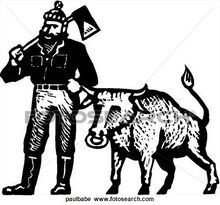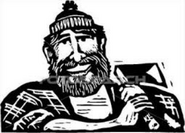
Paul Bunyan is a lumberjack figure in North American folklore and tradition. One of the most famous and popular North American folklore heroes, he is usually described as a giant as well as a lumberjack of unusual skill, and is often accompanied in stories by his animal companion, Babe the Blue Ox.
The character originated in folktales circulated among lumberjacks in the Northeastern United States of America and eastern Canada, first appearing in print in a story published by Northern Michigan journalist James MacGillivray in 1906. The stories then found widespread popularity after being reworked by William Laughead for a logging company's advertising campaign beginning in 1914. The 1922 edition of Laughead's tales inspired many others, and the character thereafter became widely known across the United States and Canada. As Bunyan's popularity came only after the stories appeared in print, some commentators consider him an inauthentic "fakelore" character.
According to writer James Stevens in his 1925 book Paul Bunyan, French Canadians gave birth to the tales during the Papineau Rebellion of 1837, when they revolted against the young English Queen. This, some have thought, would explain the origin of Bunyan's last name, since "Bonyenne" is a colloquial French-Canadian expression of surprise and astonishment meaning "Good grief" or "My goodness". But as John Brown's detailed study of the 17th-century writer John Bunyan showed, Bunyan is a well-known English surname, Norman in origin (Buignon), of a family first recorded as living in the Bedford area in the late 12th century. The name is also found in Normandy in the early Middle Ages.
One legend says that at the mouth of the river in the Two Mountains area near Saint-Eustache, Quebec, loggers stormed into battle against the British. Among them was a fierce and bearded giant named Paul Bonjean, or "Bonyenne". (Another series of related legends are based on the feats of an actual man having lived in logging camps in the Ottawa Valley named Big Joe Mufferaw or Joseph Montferrand.) The legends about this defender of the people moved upriver from shanty ("chantier" in French) to shanty. His name was anglicized and the stories were modified and elaborated upon from storyteller to storyteller.
Much of the Paul Bunyan legend, and specifically the idea of Bunyan as a giant lumberjack with a giant blue ox sidekick, was created in the 20th century for an advertising campaign. Although it is claimed in some sources that "there is no documentary evidence of any Paul Bunyan story being told before James MacGillivray's story 'The Round River Drive,' published in 1910," MacGillivray had published some stories in the Oscoda, Michigan, Press on August 10, 1906, and Governor of Michigan Jennifer M. Granholmproclaimed the centennial of that date as "Paul Bunyan Day".
MacGillivray's story does not suggest that Paul Bunyan was a giant and contains no mention of a blue ox companion. But J.E. Rockwell had written about lumberjack tales of Paul Bunyan, and mentioned the (unnamed) blue ox in the February 1910 issue of the magazine The Outer's Book. According to one tale noted by Rockwell, Bunyan was "eight feet tall and weighed 300 pounds."Historian Carleton C. Ames (whose son Aldrich Ames would later become a notorious spy) claimed in a 1940 article that Paul Bunyan was a 20th-century invention rather than a 19th-century lumber camp folk hero. William Laughead, an advertising copywriter who had once worked in lumber camps, took the stories of an old lumberjack and reworked them into the modern character. He sold his character to the Red River Lumber Company, which published "Introducing Mr. Paul Bunyan of Westwood, California" in 1916 as an advertising pamphlet. Among other things, Laughead gave the name "Babe" to the blue ox, originated the idea that Paul Bunyan and Babe were of enormous size, and created the first pictorial representation of Bunyan. Authors Richard Dorson and Marshall Fitwick cite Paul Bunyan as an example of "fakelore", or a modern story passed off as an older folktale.
Bunyan's birth was somewhat unusual, as are the births of many mythic heroes, as it took five storks to carry the infant (ordinarily, one stork could carry several babies and drop them off at their parents' homes). When he was old enough to clap and laugh, the vibration broke every window in the house. When he was seven months old, he sawed the legs off his parents' bed in the middle of the night. Paul and his companion Babe the Blue Ox dug the Grand Canyon when he dragged his axe behind him. He created Mount Hood by piling rocks on top of his campfire to put it out.
Gallery[]
<gallery
</nowiki>






